Deathunter88
National Hazard
   
Posts: 508
Registered: 20-2-2015
Location: Beijing, China
Member Is Offline
Mood: No Mood
|
|
Preparation of Neodymium Sulfate from Magnets
Extracting Neodymium From Magnets
By: Deathunter88
Abstract:
There are many types of magnets in wide use, but currently the strongest permanent magnets are neodymium magnets, which are made of a sintered powder
of an alloy made from neodymium, iron, and boron with the formula Nd2Fe14B. Thus, this makes it a convenient source of neodymium for the amateur
chemist.
Theory:
The separation of the neodymium from the iron and boron occurs in a few different steps. First, the magnet is dissolved in some dilute sulfuric acid
to form iron and neodymium sulfate. Meanwhile, the elemental boron is left behind since it is not soluble in dilute acid. Then the mixture is heated
to take advantage of the inverse solubility of neodymium sulfate. While most substances (including iron sulfate) are more soluble at high
temperatures, neodymium sulfate is unique in that its solubility decreases with increasing temperature. As the solution of the two sulfates is heated,
the neodymium sulfate crystallizes out.
Equipment:
Hotplate
Electronic mass balance
100ml graduated cylinder
250ml beaker
150mm crystallizing dish
Buchner funnel
Vacuum pump
Vacuum filtration flask
Blowtorch
#120 Sandpaper
Chemicals:
Neodymium magnet (Acid amount is given for a 50.00g magnet)
300ml dilute sulfuric acid ~30% (I used battery acid)
Distilled water
Procedure:
1. The magnet is heated strongly with the blowtorch until the curie temperature is reached and all magnetism is destroyed.
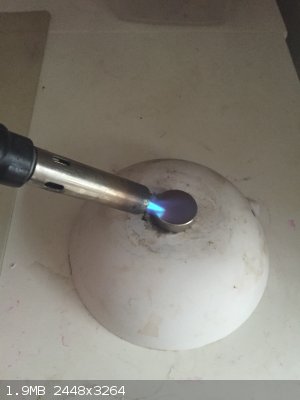
2. The Ni-Cu-Ni coating on the magnet is removed using the sandpaper in order to allow the acid to better attack the metal.
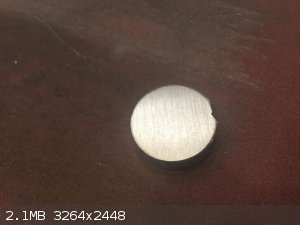
3. 200ml of the sulfuric acid is measured out using the graduated cylinder and poured into the beaker.
4. The magnet was placed into the acid and immediately a vigorous reaction is observed with plenty of effervescence.
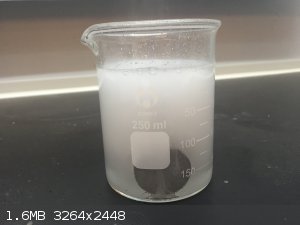
5. The beaker is allowed to sit overnight for the magnet to dissolve. (The magnet can also be broken into chunks to speed up this step)
6. After sitting overnight, the liquid is poured off and another 100ml of sulfuric acid is added to the beaker to dissolve the remainder of the
magnet.
7. After again sitting overnight, the entire magnet should be completely dissolved, but if this is not the case repeat the procedure of adding acid
and pouring off the solution.
8. Crystals of iron sulfate that have formed inside the beaker are dissolved using 100ml of distilled water.
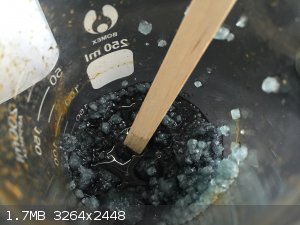
9. All of the solutions are combined and a vacuum filtration is performed to remove the insoluble boron particles.
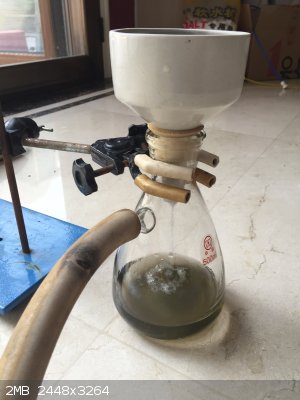
10. The filtrate is poured into the crystallizing dish which is evaporated on the hotplate set to 120˚C (the solution cannot be boiled since bumping
is a severe issue).
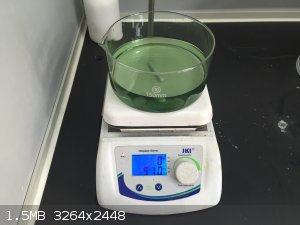
11. After 100ml of the solution has evaporated, the solution is vacuum filtered while hot to remove the neodymium sulfate that has precipitated out.
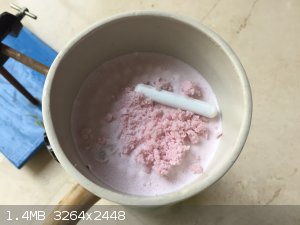
12. The neodymium sulfate is washed with some boiling water to remove the last traces of iron sulfate.
13. The remainder of the solution is again placed onto the hotplate until a further 100ml of water has evaporated and the filtering procedure is
repeated.
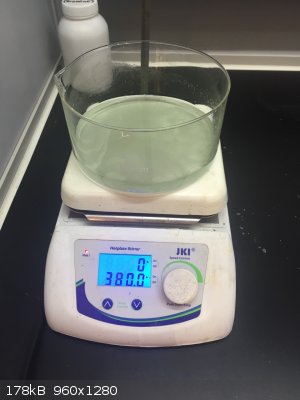
14. A third evaporation and filtering of the solution is performed just like the previous ones to recover the remainder of the neodymium sulfate.
15. After three crystallizations there is very little neodymium sulfate still in solution and so no further recovery is performed.
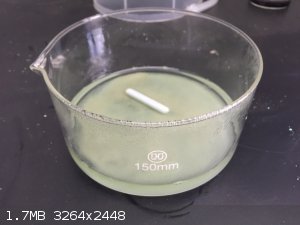
Results:
The first crystallization yielded 6.83g of product, the second crystallization yielded 9.37 grams of product, and the third crystallization yielded
3.60g of product. This totals to 19.80 grams of product total. (Right filter paper is 1st crystallization, vial is 2nd crystallization, left filter
paper is 3rd crystallization)
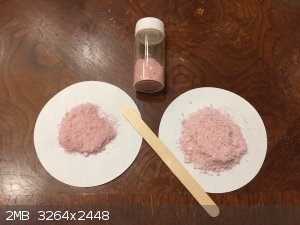
According to the formula stated above, the molar mass of "neodymium magnet" is (144.24*2)+(55.85*14)+(10.81*1)=1081g/mol. Thus, the 50.00g of magnet
that I used is 0.04625 moles, and since each mole of "neodymium magnet" contains 2 moles of neodymium, there should be a theoretical 0.09251 moles of
neodymium in the magnet. One mole of neodymium sulfate contains 2 moles of neodymium so a maximum theoretical 0.04625 moles of neodymium sulfate could
have been produced. One mole of neodymium sulfate octahydrate has a mass of 720.794 grams so the theoretical yield is 33.34 grams. The yield of this
experiment is 19.80 grams which is a 59.39% yield. The reason for this mediocre yield is that at first I attempted to boil down the solution which
resulted in major losses from bumping. Otherwise, the yield would probably have been higher.
Conclusion:
I feel that this was a pretty successful extraction and that the final product is reasonably pure. However, each crop of crystals is slightly
different. The first crystallization resulted in a fluffy powder that is less crystalline compared to the second crop. The second crop is the most
crystalline and the densest, while the last crop seems to be a mix of the first two. This confuses me and suggests that a recrystallization may be
needed.
|
|
|
DFliyerz
Hazard to Others
  
Posts: 241
Registered: 22-12-2014
Member Is Offline
Mood: No Mood
|
|
Beautiful crystals! I'm glad that someone finally posted a procedure, seeing as the other really good one on versuchschemie is gone.
|
|
|
ficolas
Hazard to Others
  
Posts: 146
Registered: 14-5-2016
Member Is Offline
Mood: No Mood
|
|
Thaks for this! I was about to do the same thing, but working blind with my small knowledge in chemistry would be bad, so I was going to ask if my
procedure was right, guess I no longer need to!
I failed at the separating the neodymium and iron sulfates part, I didnt know about the solubility of neodymium sulfate decreasing with temperature.
Do you guys know any source of praseodymium? I would also like to get some praseodymium sulfate
[Edited on 2-6-2016 by ficolas]
[Edited on 2-6-2016 by ficolas]
|
|
|
aga
Forum Drunkard
    
Posts: 7030
Registered: 25-3-2014
Member Is Offline
|
|
Great write-up !
Why destroy the magnetism before dissolution ?
When i tried this i got a similar-coloured powder, and let the magnet go out "with it's boots on".
Edit:
| Quote: | | each crop of crystals is slightly different |
This tends to be the case with crystals.
The precise mix of product/contaminants, ratio of product/contaminant/solvent, speed of cooling etc all affect how the crystals grow.
A recent batch of sodium sulphate came out as saw-toothed spikes, fine crystals and sheets, all from the same original batch.
[Edited on 2-6-2016 by aga]
|
|
|
Hegi
Hazard to Others
  
Posts: 199
Registered: 27-9-2013
Member Is Offline
Mood: No idea.
|
|
Very nice write-up. I´ll do this in near future! I am also interested in the question aga wrote. What is a purpose of destroying magnetism? 
Our webpage has been shut down forever cause nobody was willing to contribute. Shame on you all!!!
|
|
|
blogfast25
International Hazard
    
Posts: 10562
Registered: 3-2-2008
Location: Neverland
Member Is Offline
Mood: No Mood
|
|
Nice write up and nice looking product.
But I'd strongly advise checking it for Fe (e.g. with some peroxide and KSCN or NH4SCN). Fe and Nd aren't that easily separated 100 %. A
certain degree of co-precipitation/co-crystallisation is hard to avoid.
[Edited on 2-6-2016 by blogfast25]
|
|
|
Deathunter88
National Hazard
   
Posts: 508
Registered: 20-2-2015
Location: Beijing, China
Member Is Offline
Mood: No Mood
|
|
Quote: Originally posted by blogfast25  | Nice write up and nice looking product.
But I'd strongly advise checking it for Fe (e.g. with some peroxide and KSCN or NH4SCN). Fe and Nd aren't that easily separated 100 %. A
certain degree of co-precipitation/co-crystallisation is hard to avoid.
[Edited on 2-6-2016 by blogfast25] |
Yeah I need to check it for iron contamination, but I have to order some KSCN first.
|
|
|
Deathunter88
National Hazard
   
Posts: 508
Registered: 20-2-2015
Location: Beijing, China
Member Is Offline
Mood: No Mood
|
|
Quote: Originally posted by Hegi  | Very nice write-up. I´ll do this in near future! I am also interested in the question aga wrote. What is a purpose of destroying magnetism?  |
I guess you don't NEED to destroy the magnetism, but it makes working with the magnets a lot easier. These magnets are very strong and if you aren't
careful you will get blood blisters or maybe even broken fingers. The magnet I used has a pull force of 40lb based on this calculator by K&J magnetics. Also, if you plan to smash the magnet with a hammer you can't have the magnet sticking to the hammer.
|
|
|
aga
Forum Drunkard
    
Posts: 7030
Registered: 25-3-2014
Member Is Offline
|
|
These are very good reasons to demagnetise.
Thanks !
|
|
|
j_sum1
Administrator
       
Posts: 6231
Registered: 4-10-2014
Location: Unmoved
Member Is Offline
Mood: Organised
|
|
Also getting the nickel coating off is tricky when it is magnetic.
|
|
|
MrHomeScientist
International Hazard
    
Posts: 1806
Registered: 24-10-2010
Location: Flerovium
Member Is Offline
Mood: No Mood
|
|
Nice writeup. I feel obliged to link to the long-running thread on separating Nd from these magnets, here: http://www.sciencemadness.org/talk/viewthread.php?tid=14145
All of the questions in this thread are answered there. It's a long read, but well worth it.
I initially used the inverse-solubility approach for separation, but it was very tedious and I could never get that last bit of Nd out. A much better
method, pioneered by blogfast, is to use double salts. Adding solid potassium sulfate crashes out a very insoluble K-Nd double salt, affording a
quick, easy, and near-complete separation from iron.
Finally if you haven't tried it, make a solution of an Nd salt and look at it under different lighting. The color changes dramatically between
sunlight, incandescent bulb, short fluorescent tube lights, and large fluorescent tube lights.
|
|
|